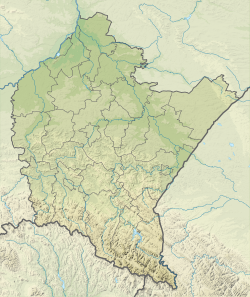|
Łańcut Synagogue
The Łańcut Synagogue is a former Jewish congregation and synagogue, located in Łańcut, in Podkarpackie Voivodeship, Poland. Completed in 1761, it served as a house of prayer until World War II; subsequently used for profane purposes, and as a Jewish museum since 1981. The Łańcut Synagogue is a rare surviving example of the vaulted synagogues with a bimah-tower,[2] that were built throughout the Polish lands in masonry from the sixteenth through the early nineteenth centuries. HistoryThe synagogue was built in 1761, on the site of an earlier wooden synagogue which was destroyed by fire in 1733. Its construction was financed by Prince Stanisław Lubomirski.[3][4] It was renovated in 1896 and 1910. In September 1939, the building was set on fire by the invading German Army, however, the building was saved from total destruction by Count Alfred Antoni Potocki and converted into a granary. After the war, the synagogue came into the ownership of the local council, and was occasionally used as an exhibition space. It became a Judaica museum in 1981. The building was superficially renovated in the 1960s, and again more thoroughly from 1983-1990.[5][6] ArchitectureThe synagogue is a simple Baroque, masonry building with a vestibule and side room, main hall and a women's balcony above the vestibule reached by an exterior staircase.[7] The windows of the main hall are unusually large for a Polish synagogue; Krinsky believes that this may reflect the security of the Jews in Łańcut, who lived under the protection of the landowning family.[7] The synagogue is built with eight, barrel-vaulted bays around a central Bimah, the four, massive, masonry pillars of which support the ceiling and roof. Painted, decorative plasterwork adorns the pillar capitals, ceiling, and walls. The floor in the restored building is made of concrete.[7] The walls are decorated reproductions of the pre-war paintings. The original paintings were created in the 18th century, with more being added around 1900. They feature traditional Jewish subjects, such as Noah and the Ark, symbols of the Zodiac, and images of musical instruments mentioned in the Book of Psalms.[8][7] Gallery
See alsoReferences
External linksWikimedia Commons has media related to Łańcut Synagogue. |
||||||||||||||||||||||||||||||||||||||





